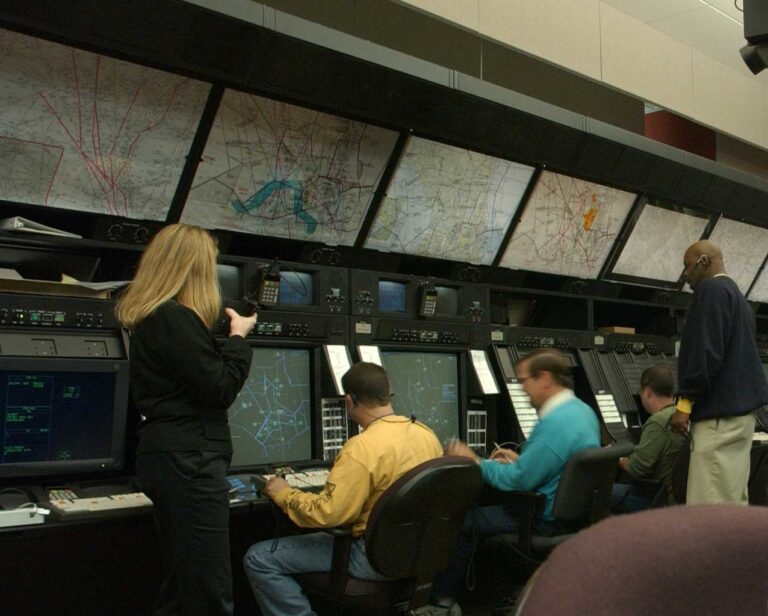
The Trump administration’s decision to slash staffing at the Federal Aviation Administration (FAA) raised concerns among aviation professionals and industry experts. Critics argue that the move could exacerbate an already strained aviation system, leading to potentially dangerous consequences. This article examines the rationale behind these cuts, their potential impacts on air safety, and the broader implications for the U.S. aviation sector.
The Federal Aviation Administration, tasked with regulating and overseeing aviation safety in the United States, plays a crucial role in maintaining the integrity of the nation’s air travel system. The FAA is responsible for monitoring air traffic control (ATC), enforcing safety standards, certifying aircraft, and training the personnel who ensure the safe and efficient operation of the aviation system.
In a country that boasts the world’s largest and busiest air traffic network, the FAA’s role cannot be overstated. The agency employs thousands of highly trained professionals, from air traffic controllers to safety inspectors, who work tirelessly to prevent accidents and ensure the continued operation of U.S. air travel. Any reduction in staffing within the FAA could put this delicate balance at risk.
In 2018, the Trump administration proposed significant cuts to the FAA’s workforce as part of a broader effort to reduce federal spending. The proposal included reducing the number of air traffic controllers, safety inspectors, and other critical staff members who are responsible for maintaining the smooth operation of the U.S. airspace system.
While the administration argued that these cuts were necessary to reduce the size of government and improve efficiency, many in the aviation industry expressed alarm. They pointed out that the U.S. aviation system was already operating at full capacity, with air traffic control facilities stretched thin, and that cutting staff could lead to slower response times, increased delays, and more opportunities for human error.
Air traffic control is a highly complex and demanding task that requires constant vigilance and coordination. Air traffic controllers work under immense pressure to manage the flow of thousands of flights each day, ensuring that planes maintain safe distances from one another and are routed efficiently through the airspace.
Staffing reductions at air traffic control centers could lead to longer shifts for remaining personnel, increasing the likelihood of fatigue and diminishing their ability to manage air traffic safely. Fatigue is a known contributor to human error, and with fewer controllers, the margin for error could narrow significantly, putting the safety of passengers and crew at risk.
In addition to air traffic control, the FAA is also responsible for certifying aircraft and conducting safety inspections. Aircraft manufacturers and maintenance facilities rely on FAA inspectors to ensure that airplanes meet rigorous safety standards before they can be approved for flight. A reduction in FAA staffing could delay the certification process for new aircraft or create backlogs in safety inspections for existing planes.
A failure to meet safety standards could result in faulty equipment going undetected, raising the risk of technical failures and accidents. In a worst-case scenario, this could lead to catastrophic incidents involving commercial aircraft, undermining public trust in the safety of air travel.
As the Trump administration’s budget proposal moved forward, industry stakeholders including pilots’ unions, airline associations, and safety advocates raised alarms about the potential consequences of FAA staff cuts. The National Air Traffic Controllers Association (NATCA) warned that reducing the workforce would compromise safety and lead to longer wait times for passengers.
Additionally, airline executives expressed concerns about the potential for flight delays and cancellations resulting from a reduced FAA presence. With fewer controllers available to manage air traffic, it would become increasingly difficult to maintain efficient operations, especially at busy airports. The cascading effects of delays could ripple across the entire airline industry, leading to a decline in service quality and passenger satisfaction.
In response to mounting pressure from aviation professionals and lawmakers, the Trump administration eventually backtracked on some of its proposed cuts. However, concerns remained that even partial reductions in FAA staffing could still have a detrimental effect on air safety. Lawmakers on both sides of the aisle called for increased funding for the FAA to ensure that air traffic controllers and safety inspectors had the necessary resources to do their jobs effectively.
Safety experts also pointed out that the FAA’s budget was already stretched thin, and additional cuts could further hinder its ability to keep up with the demands of an increasingly complex aviation system. The United States’ air travel infrastructure was already operating under significant strain, with airports and air traffic control centers struggling to accommodate a growing number of flights and passengers.
As the debate over FAA staffing cuts continued, many in the aviation community expressed concerns that the Trump administration’s actions could set a dangerous precedent. By prioritizing budget cuts over safety and efficiency, the administration risked eroding the long-standing commitment to maintaining the safest and most efficient aviation system in the world.
If the FAA were to continue reducing its staff in the years ahead, the agency’s ability to respond to emergencies, address technological advancements, and adapt to the evolving needs of the aviation industry could be significantly compromised. The resulting risks to public safety and economic stability could be far-reaching, with long-lasting consequences for the entire U.S. aviation ecosystem.
The decision to cut FAA staffing should not be taken lightly. While fiscal responsibility is important, it must not come at the expense of air safety and the efficiency of the nation’s air traffic system. The risks of undermining the FAA’s ability to effectively manage air traffic, conduct inspections, and certify aircraft are far too great.
As the aviation industry continues to evolve, it is essential that the government prioritize investment in the FAA’s workforce and resources. Ensuring that the FAA has the staff and support it needs to maintain a safe and efficient air travel system is not just a matter of economic concern it is a matter of public safety.

